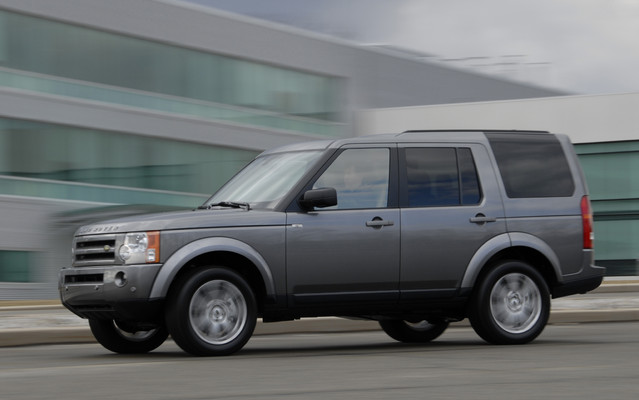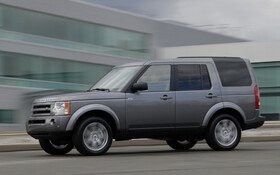Rule, Brittania! The 2009 Land Rover LR3
I love Land Rovers. In fact, I am writing this review on a laptop which has a particularly dashing picture of my own 1973 Land Rover Series III 88” station wagon as the wallpaper. I own no less than three Land Rover articles of clothing, and use a pen from my local Land Rover parts supplier to take notes during press junkets. My garage is stocked with an odd assortment of boxes alternating Lucas and Land Rover Genuine Parts labels, and there is a permanent gear oil stain in my driveway located squarely under my old Land Rover’s transfer case. During the winter, I dress as if I’ll be walking everywhere, for a 1973 Land Rover’s heater is located approximately 150 million kilometres away, on the other side of Mercury. I do not venture into the passing lane, for the majority of the 75 horsepower found under the faded green paint of the bonnet have long since died away at a rate that I would conjecture to be about one for every year of operation. In fact, the throttle pedal is more of a cajoling pedal; just as the brake pedal seems to be more of a suggestion. They make a good couple.
But still I love them. Their rugged practicality combined with their ability to go absolutely anywhere (given enough time) combines with their old-world charisma and charm in a way that no other vehicle on the road has managed to emulate. They make no concessions to anything, and are the ultimate expression of form following function. Originally designed as tractors, they grew their aluminum alloy bodies out of necessity; scrap aluminum being the only plentiful metal in post-WWII England. Even the original colour, a faded shade of green, was leftover paint utilized during wartime to coat military aircraft cockpits. They are the single longest surviving vehicles on the road, with somewhere near 70% of all Land Rovers ever produced still roaming roads and tracks around the world, and are the first vehicles ever seen by most people in developing nations. All this ruggedness, and yet they are still the choice of royalty.
So, on a cold and rainy Vancouver day, I stuffed my woollen feet into waterproof boots, wrapped my neck in an ex-Canadian Army scarf, and slid behind the wheel of my ex-British Army Land Rover. Covering the larger holes in the bulkhead with my booted foot so as to reduce the influx of water into the driver’s side footwell, I considered my destination through the rain-streaked, postage stamp-sized pane of uncoated, untempered glass that passed as a windshield almost four decades ago. A thoroughly modern Jaguar and Land Rover dealership located in the heart of a trendy west coast auto mall, replete with multiple independent coffee shops. Because Starbucks is so passé.
To say I felt out of place clumping into the silent showroom would be a massive understatement. To say the sales staff thought I was out of place would be an even bigger one. However, the receptionist was all too willing to shuffle me back into the service shop’s offices (and possibly out of view of the car buying public), where I would be handed the keys to a shiny black 2009 Land Rover LR3 that waited, ironically, at the opposite end of the building from where my Series III was undoubtedly already leaving it’s mark upon the pavement below. Walking out to the hulking black behemoth, I was surprised at the similarities in shape. Although the stepped roof and silhouette may draw more parallels with the older Discovery line, there’s undeniable Land Rover lineage at work in the bodylines. The upright grill, tall profile, preponderance of glass, and flat rear end all date back to the first Land Rovers, and the rear side windows that curve from the bodysides to the roof pay homage to the alpine windows found on later Series trucks and modern Defenders. Even the concessions to modern styling build on Land Rover’s illustrious heritage; such as the air intake vent found on the right front fender that mimics that found on my own Series truck.
But opening the door exposed the progress of 36 years. Where older Land Rovers feature lightweight doors with only the most rudimentary lock mechanisms and push-to-open windows, the LR3’s are vault-like in their weight, a comfort for those safety conscious buyers who also like the operation of their windows and locks to be just a button’s away. Sliding into the soft and supple seat, another difference becomes apparent: space. Being of relatively boxy dimensions, the LR3 features massive amounts of room in absolutely every direction, a sensation that’s only enhanced by the low window sills and expansive greenhouse. Sitting quite high above the diminutive but informative instrument binnacle (yet another reminder of Land Rovers gone by), the view is commanding, and the squared-off edges of the hood give a good amount of confidence when manoeuvring through tight spots. For the uninitiated, the low placement of the steering wheel and high seating position could take some getting used to, but is extremely comfortable. The textures and materials used throughout the interior remind that practicality is still the order of the day at Land Rover’s Lode Lane HQ, as otherwise slippery aluminum knobs, dashboard divots, and storage bins earn grippy rubber adornments. But a lot of the controls seem oddly familiar; many of them lifted straight from the same ex-Ford Premium Auto Group parts bin that so many Volvo and Jaguar engineers have dipped into. It’s somewhat disconcerting to reach over in such a distinctly Land Rover-esque interior and feel a luxurious Volvo switch under your fingertips. Likewise, looking down at the thickly woven carpet underfoot made me think what a shame it would be if some of the land being roved was to intrude within the LR3’s upscale interior; a notion put to bed with as much ease as tugging the door shut. The feeling of the air compressing against my eardrums when the dual door seals slide home gave the impression that nothing short of a flash flood would ever muddy this interior.
Not that one should ever encounter such an event in a truck that comes stock with a weather band radio; just one of the many technologies designed to keep LR3 owners safe throughout off-road excursions. Even more impressive is the adaptable air suspension, itself the culmination of years of research and development under the Range Rover platform. Long before Porsche’s Cayenne promised articulated ride height to offer easy ingress and egress as well as off-road clearance, Range Rover had the ability to move through almost six inches of suspension travel, depending on conditions. The current LR3 uses a similar system, albeit modified with a new cross-linked feature that will recognize when the vehicle is high-centered, and force the suspension to push down the wheels of two opposing corners to increase traction. Although I never was afforded the opportunity to use the LR3 off road, playing with the mode switch on pavement made it easy to see just how much of a difference in approach, departure, and breakover angles the air suspension granted. But the real icing on the cake is the much-lauded Terrain Response System. Consisting of a dial in the center console, this system allows the driver to simply select from any one of five available settings corresponding to various road (or lack thereof) conditions. Whether it be pavement, grass/gravel/snow, mud/ruts, sand, or rocks, the system adapts to the ground underfoot my adjusting the suspension, braking, traction control, and throttle response to maintain forward progress. All of this is tied together by an on-screen display that spits out real time suspension information, including the status of the terrain response system, wheel travel and articulation, transfer case operation, as well as center and rear differential lockup, if so equipped.
However, given my solitary week within the pleasurable confines of the LR3 would be stocked with five days’ worth of meetings, photo shoots, and interviews capped off with a weekend of mandated antique shopping and wine tastings, my time aboard the newest Land Rover I’d ever set foot in would pass atop the macadam streets of Vancouver’s urban sprawl. Although appearing bulky and overly large, the LR3 only outgrew the Discovery 2 by four inches in overall length, and as I’d mentioned, the boxy shape gives one a good feeling for where the vehicle’s outer limits are. This, and an array of radar sensors made the black Brit downright easy to slide through traffic and parking lots, and the excellent visibility in every direction made navigating Vancouver’s congested streets as easy as it could possibly be. However, as good as it proved to be in the cut and thrust of inner city traffic, the Land Rover proved itself significantly less eager to thrust than to cut. Equipped with an admittedly healthy, but now aging 4.4 litre V8 borrowed from Jaguar, the 300 horsepower and 315 ft. lbs. of torque it supplies seems inadequate when it comes to shoving the 5,796 pounds of steel, aluminum, plastic, and leather around. And let me tell you, stuffing a few hundred more pounds worth of beaten up and overpriced... er... antique table in the back doesn’t help. But, with the advent of the LR4 coming in 2010 and bearing a new 5.0L V8 underhood, you shouldn’t expect to hear many complaints about lacklustre performance in the future.
In fact, you shouldn’t expect to hear any complaints at all when the LR4 breaks cover next year. Improving upon the LR3 with over 300 revisions, the LR4 promises to continue moving Land Rover’s cheapest full-size offering even further upscale. This is hard to believe given how good the LR3 already is. Although the motor may be the weakest link, it’s only exposed as such by the exceedingly high quality of absolutely everything else. Often compared to vehicles costing far more, the LR3 provides good value for the money in terms of overall engineering, safety, and quality, and is without equal when it comes to capability. The suspension provides an excellent ride that is both magic-carpet smooth and yet still composed, and the interior remains one of the most pleasant I’ve ever had the enjoyment of occupying. But by far the most important thing about the LR3 is the manner in which it makes you forget it’s even there. While the various other SUV-shaped offerings remind the driver of their existence with insistent navigation warnings, complex control interfaces, on-screen displays, reverberating exhausts, and downright dominating dashboards, the LR3 is perfectly content to whisk its occupants along in complete repose. It doesn’t dominate your vision with overgrown dashboards and consoles, and it doesn’t endeavour for a sports car’s profile with low windows and a hunkered down stance. Instead, it offers up a commanding seating position, fantastic sight lines through panoramic windows in every direction, and an utterly smooth and unfettered ride. There are no bizarre control interfaces, and there’s nary a needless gizmo to be found; instead every feature is easily accessed and manipulated with simple buttons and dials. And it’s in this outward focus that the LR3 finds the most in common with the Land Rover’s that gave rise to the company’s legendary status. And although it may be far removed from the cold, damp, and archaically simple Series III I clambered into seven days later, it`s every bit as worth of the badge on the grille.












